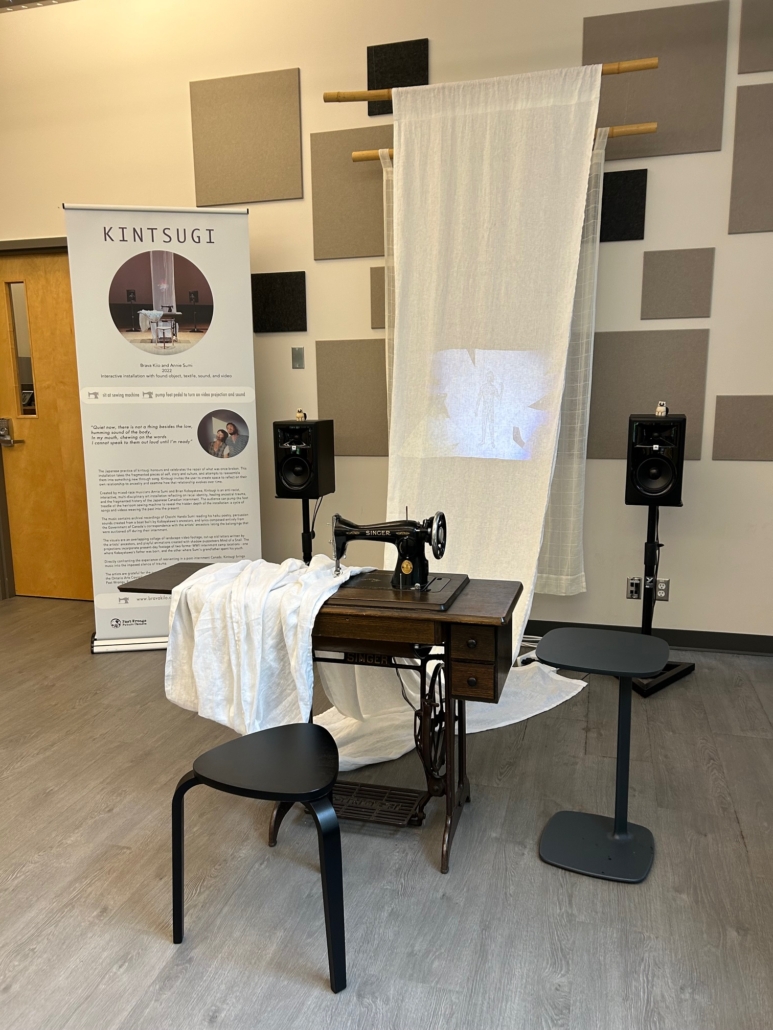Kintsugi: An Exploration of Fragmented Histories and Healing at the University of Victoria (UVIC) Library

Kintsugi at the UVIC Library. Photo credits: Michael Abe.
Opening on August 9, 2024, the Kintsugi exhibition at UVIC Library presents a powerful, multi-sensory installation by mixed-race musicians Annie Sumi and Brian Kobayakawa (Brava Kilo). This site-specific, interactive installation invites viewers into a reflective and deeply emotional space where history, identity, and ancestral trauma intersect.
At its core, Kintsugi centers around four co-written songs that anchor the experience, each offering a sonic journey through fragmented personal and cultural histories. The metaphor of Kintsugi, inspired by the Japanese art of repairing broken pottery with gold, extends beyond objects to encompass stories, culture, and personal histories fractured by systemic racism and trauma.
The installation features found objects, textiles, sound, and video, asking visitors to engage with the work on a physical level. By sitting at an heirloom sewing machine and pumping the foot pedal, participants activate video projections and a deeply immersive song cycle. As the sewing machine hums, a series of videos and songs weave the past into the present. Sumi sings and plays guitar, while Kobayakawa plays bass, synthesizers, and samplers, alongside contributions from other musicians.
One of the four songs draws its lyrics directly from historical correspondence—letters detailing the belongings auctioned off during the Japanese Canadian internment, while the others are original compositions reflecting the artists’ ancestral stories. This blend of archival material and artistic imagination invites visitors to meditate on the silences imposed by historical trauma and the potential for healing.
Archival recordings of haiku poetry by Annie’s grandfather, Choichi Hando Sumi, as well as percussive sounds made from a boat built by Kobayakawa’s ancestors, further enrich the installation. The visuals combine footage from WWII internment camps—including one where Kobayakawa’s father was born and another where Sumi’s grandfather spent his youth—with cut-up family letters and playful shadow puppet animations by Mind of a Snail.
The Kintsugi installation is the product of extensive research, with Landscapes of Injustice playing a key role in guiding the creation of the songs and the installation itself. This layered approach reflects the complexity of reassembling fractured identities in post-internment Canada, offering a contemplative space to confront both collective and personal histories.
Interview with Brava Kilo (Brian Kobayakawa) and Annie Sumi: Kintsugi as Reflection and Resistance
Q1: Can you tell us about the inspiration behind Kintsugi? How did your personal histories influence the creation of this installation?
Brian Kobayakawa (BK): This work began as a commission from the Japanese Canadian Cultural Centre in Toronto. They asked for some original compositions and a performance. We had no idea at first that it might become a traveling installation! The pandemic played a role in the time and pace of creation. But more than anything, the most inspiring part was having a collaborator with whom I could discuss Japanese Canadian internment and how our families were impacted, without needing to provide context. Creating this piece provided a safe place to compose, question, and learn, in a way that is very different from anything I could have achieved on my own.
Annie Sumi (AS): Before we began this project, I had never connected with someone my age about the internment. Through this collaboration, Brian and I were able to share stories about the challenges of growing up displaced from our Japanese Canadian history and culture. The process revealed pathways that allowed us to sit with the pain of our ancestors, try to speak to the impact, and playfully begin unpacking as a way to understand ourselves more.
Q2: This piece is deeply rooted in both sound and visual elements. How did you approach blending these two mediums to convey the themes of healing and identity?
BK: Both Annie and I are musicians with little experience as visual artists. The blend was all experimentation and trial and error. We trusted our instincts. We also hired shadow puppeteers that we admire greatly— the Vancouver-based duo Mind of a Snail—who helped translate our ideas into the initial images. Annie wanted shadow puppeteering to be part of this even before we knew what form the work would take.
AS: A lot of the visuals incorporate footage Brian captured of the Slocan and Rosebery internment locations. You can see the landscapes as they are today, with superimposed, surreal shadow animations that honor the stories those landscapes have witnessed. Music has always been a companion to my imagination, and when we were writing these songs, in my mind, they were accompanied by powerful imagery: the ancestor on the bridge, the child running, the trains, and the pines and mountains. Mind of a Snail brought all of our whimsical visions to life, and the rest was all editing work!
Q3: The audience plays an active role in the installation by operating the sewing machine. What do you hope this interactive element adds to the viewer’s experience?
BK: The interactive component was initially a result of creating this work in the thick of the pandemic when distance and isolated experiences were front of mind for everyone. That, combined with the realization (thanks to the Landscapes of Injustice archive) that my Bachan’s sewing machine had a story I wasn’t aware of, added meaning. The sewing machine had been in my parents’ home since I was a child. We’ve realized engaging the audience physically in this way is something different from anything our previous experiences as musicians allowed. The metaphor of asking for permission to talk about some heavy things through this physical interaction and the individual response required from the audience is a very powerful component.
AS: Ditto everything Brian said! I think giving the audience agency to interact with the machine deepens the potential impact. In my experience with other audience-operated art pieces, it feels like the artist is saying, “You will get whatever you are willing to give,” and I think there’s power in that. It makes people want to know more.
Q4: The music incorporates archival material from your ancestors and objects tied to your family histories. How did you approach the emotional weight of this material when creating the installation?
BK: Very slowly and carefully!
AS: Yes, very tenderly. I remember reading those documents and crying on my kitchen floor in the middle of the night. It is bizarre to read the handwriting of your great-grandparents and hear the desperation in their words as they plead for their belongings, for resources, and for information. I think I texted Brian after that night and just said, “Heads up, this is hard… go slow.”
Q5: Kintsugi addresses the experience of healing from ancestral trauma, particularly within the context of Japanese Canadian internment. How do you see this installation contributing to the ongoing conversation about racial identity and post-internment Canada?
BK: Though this work has been therapeutic for me in many ways, and I know we’re both proud of any part it may have played in inspiring conversations around internment or other hard-to-look-at parts of anyone’s family history, I don’t agree that it directly addresses the experience of healing from trauma. I see it more as a series of experiments where, ideally, our songs and the installation can simply create a space for looking at ancestral stories—both ours and the audience’s.
AS: Someone once told me, “Go to the river. When you have a question, look upstream; when you need to let something go, look downstream.” For me, this entire project has felt like standing in the river looking upstream. Through making the music, having conversations, and sharing laughter, we have started turning downstream. Like Brian, this work has been deeply cathartic for me, but I don’t know that I fully understand what “healing ancestral trauma” means. I believe Kintsugi has provided a safe container to talk about challenging stories, and given us a creative opportunity to deepen our understanding of ourselves, how we came to be, and who we come from. It would be incredible if this piece can inspire others to look, with love, at their own family stories, and I hope we continue to find inspiration in connecting with our ancestors.
Q6: Working on a project like this is deeply personal. What was the most challenging and rewarding part of creating Kintsugi, and how do you hope it resonates with visitors?
BK: The most challenging part was getting out of my own way. The most rewarding part was also getting out of my own way! While I’m sincerely grateful for any and every way this work might resonate with an audience, I’m trying hard lately to reduce my concern over how someone will interpret or experience something I create. Not only because those resonances are something I can’t ever hope to control or predict, but also because I think creating with a level of disinterest in audience reaction is likely the path to making music with more honesty and truth at the core.
AS: (I love Brian’s answer.) I think the biggest challenge for me was keeping momentum. We would have deep dives into the creation and long periods of break. It was hard sometimes to sink back into the project with all the space in between. That being said, I think it was necessary for us to have those spaces where we could just not give ourselves a hard time about the work! For me, the most rewarding thing has been the support we’ve received through this work. I don’t think either of us had any idea or expectation that Kintsugi would be so well received. It has brought me such joy to feel the excitement from the Japanese Canadian community and to bring the work across Canada to connect with other organizations and demographics.
This article was written by Ciel Dong, based on an interview with Brian Kobayakawa and Annie Sumi, in October 2024.

 Instagram
Instagram